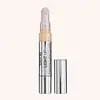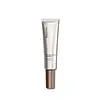What's inside
What's inside
 Key Ingredients
Key Ingredients

 Benefits
Benefits

 Concerns
Concerns

 Ingredients Side-by-side
Ingredients Side-by-side

Water
Skin ConditioningCyclopentasiloxane
EmollientMica
Cosmetic ColorantCyclohexasiloxane
EmollientButylene Glycol
HumectantPEG-10 Dimethicone
Skin ConditioningGlycerin
HumectantKaolin
AbrasiveDipentaerythrityl Pentaisononanoate
EmollientPhenyl Trimethicone
Skin ConditioningCetyl PEG/PPG-10/1 Dimethicone
EmulsifyingSodium Chloride
MaskingDisteardimonium Hectorite
StabilisingTrimethylsiloxysilicate
EmollientBenzyl Alcohol
PerfumingPropanediol
SolventTriethoxycaprylylsilane
Magnesium Stearate
Cosmetic ColorantTalc
AbrasiveAluminum Hydroxide
EmollientSalicylic Acid
MaskingTin Oxide
AbrasiveSorbic Acid
PreservativeHydrogen Dimethicone
Vitis Vinifera Juice Extract
AntioxidantCI 77891
Cosmetic ColorantCI 77491
Cosmetic ColorantCI 77492
Cosmetic ColorantWater, Cyclopentasiloxane, Mica, Cyclohexasiloxane, Butylene Glycol, PEG-10 Dimethicone, Glycerin, Kaolin, Dipentaerythrityl Pentaisononanoate, Phenyl Trimethicone, Cetyl PEG/PPG-10/1 Dimethicone, Sodium Chloride, Disteardimonium Hectorite, Trimethylsiloxysilicate, Benzyl Alcohol, Propanediol, Triethoxycaprylylsilane, Magnesium Stearate, Talc, Aluminum Hydroxide, Salicylic Acid, Tin Oxide, Sorbic Acid, Hydrogen Dimethicone, Vitis Vinifera Juice Extract, CI 77891, CI 77491, CI 77492
Water
Skin ConditioningDimethicone
EmollientEthyl Trisiloxane
Skin ConditioningPEG-10 Dimethicone
Skin ConditioningHdi/Trimethylol Hexyllactone Crosspolymer
Talc
AbrasiveBoron Nitride
AbsorbentPropanediol
SolventGlycerin
HumectantCaprylyl Methicone
Skin ConditioningTrimethylsiloxysilicate
EmollientSodium Chloride
MaskingPhenoxyethanol
PreservativeAlbizia Julibrissin Bark Extract
MaskingSodium Dehydroacetate
PreservativeC30-45 Alkyl Cetearyl Dimethicone Crosspolymer
EmollientHydrogen Dimethicone
Mica
Cosmetic ColorantAluminum Hydroxide
EmollientTetrasodium EDTA
Tocopheryl Acetate
AntioxidantAloe Barbadensis Extract
Skin ConditioningEthylhexylglycerin
Skin ConditioningSilica
AbrasiveHydrolyzed Manihot Esculenta Tuber Extract
Skin ConditioningSodium Benzoate
MaskingCI 77891
Cosmetic ColorantCI 77492
Cosmetic ColorantCI 77491
Cosmetic ColorantCI 77499
Cosmetic ColorantWater, Dimethicone, Ethyl Trisiloxane, PEG-10 Dimethicone, Hdi/Trimethylol Hexyllactone Crosspolymer, Talc, Boron Nitride, Propanediol, Glycerin, Caprylyl Methicone, Trimethylsiloxysilicate, Sodium Chloride, Phenoxyethanol, Albizia Julibrissin Bark Extract, Sodium Dehydroacetate, C30-45 Alkyl Cetearyl Dimethicone Crosspolymer, Hydrogen Dimethicone, Mica, Aluminum Hydroxide, Tetrasodium EDTA, Tocopheryl Acetate, Aloe Barbadensis Extract, Ethylhexylglycerin, Silica, Hydrolyzed Manihot Esculenta Tuber Extract, Sodium Benzoate, CI 77891, CI 77492, CI 77491, CI 77499
Ingredients Explained
These ingredients are found in both products.
Ingredients higher up in an ingredient list are typically present in a larger amount.
Aluminum Hydroxide is a form of aluminum. It can be naturally found in nature as the mineral gibbsite. In cosmetics, Aluminum Hydroxide is used as a colorant, pH adjuster, and absorbent.
As a colorant, Aluminum Hydroxide may add opacity, or reduce the transparency. Aluminum hydroxide is contains both basic and acidic properties.
According to manufacturers, this ingredient is an emollient and humectant. This means it helps hydrate the skin.
In medicine, this ingredient is used to help relieve heartburn and help heal ulcers.
There is currently no credible scientific evidence linking aluminum hydroxide in cosmetics to increased cancer risk.
Major health organizations allow the use of aluminum hydroxide in personal care products and have not flagged it as a carcinogenic risk at typical usage levels.
Learn more about Aluminum HydroxideCi 77491 is also hydrated iron III oxide. It's sole purpose is to give a red/pink hue to products.
Iron III oxides are classified as inorganic chemicals for coloring.
Synthetically created Ci 77491 is considered safer than those naturally found. This is because the synthetically created version may contain less impurities. Iron oxides are generally non-toxic and non-allergenic.
Learn more about CI 77491Ci 77492 is also hydrated iron III oxide. It's sole purpose is to give a yellow hue to products.
Iron III oxides are classified as inorganic chemicals for coloring.
Synthetically created Ci 77492 is considered safer than those naturally found. This is because the synthetically created version may contain less impurities. Iron oxides are generally non-toxic and non-allergenic.
Learn more about CI 77492Ci 77891 is a white pigment from Titanium dioxide. It is naturally found in minerals such as rutile and ilmenite.
It's main function is to add a white color to cosmetics. It can also be mixed with other colors to create different shades.
Ci 77891 is commonly found in sunscreens due to its ability to block UV rays.
Learn more about CI 77891Glycerin is already naturally found in your skin. It helps moisturize and protect your skin.
A study from 2016 found glycerin to be more effective as a humectant than AHAs and hyaluronic acid.
As a humectant, it helps the skin stay hydrated by pulling moisture to your skin. The low molecular weight of glycerin allows it to pull moisture into the deeper layers of your skin.
Hydrated skin improves your skin barrier; Your skin barrier helps protect against irritants and bacteria.
Glycerin has also been found to have antimicrobial and antiviral properties. Due to these properties, glycerin is often used in wound and burn treatments.
In cosmetics, glycerin is usually derived from plants such as soybean or palm. However, it can also be sourced from animals, such as tallow or animal fat.
This ingredient is organic, colorless, odorless, and non-toxic.
Glycerin is the name for this ingredient in American English. British English uses Glycerol/Glycerine.
Learn more about GlycerinHydrogen Dimethicone is a type of silicone.
Mica is a naturally occurring mineral used to add shimmer and color in cosmetics. It can also help improve the texture of a product or give it an opaque, white/silver color.
Serecite is the name for very fine but ragged grains of mica.
This ingredient is often coated with metal oxides like titanium dioxide. Trace amounts of heavy metals may be found in mica, but these metals are not harmful in our personal products.
Mica has been used since prehistoric times throughout the world. Ancient Egyptian, Indian, Greek, Roman, Aztec, and Chinese civilizations have used mica.
Learn more about MicaPeg-10 Dimethicone is silicone with conditioner and emulsifier properties. It mostly acts as an emollient in skincare and and humectant in haircare.
According to the manufacturer, acidic formulations decrease the stability of this ingredient. It works best in neutral or near neutral formulations.
Propanediol is an all-star ingredient. It softens, hydrates, and smooths the skin.
It’s often used to:
Propanediol is not likely to cause sensitivity and considered safe to use. It is derived from corn or petroleum with a clear color and no scent.
Learn more about PropanediolChances are, you eat sodium chloride every day. Sodium Chloride is also known as table salt.
This ingredient has many purposes in skincare: thickener, emulsifier, and exfoliator.
You'll most likely find this ingredient in cleansers where it is used to create a gel-like texture. As an emulsifier, it also prevents ingredients from separating.
There is much debate on whether this ingredient is comedogenic. The short answer - comedogenic ratings don't tell the whole story. Learn more about comegodenic ratings here.
The concensus about this ingredient causing acne seems to be divided. Research is needed to understand if this ingredient does cause acne.
Scrubs may use salt as the primary exfoliating ingredient.
Learn more about Sodium ChlorideTalc is a clay mineral. It helps absorb moisture and improve the texture of products. Like other types of clay, Talc can have a slight exfoliating effect on skin. Talc can be added to increase the volume of products.
Some Baby powders are made by combining talc with corn starch. The word "talc" comes from Latin and originates from Arabic. Talc is a mineral commonly found throughout the world.
If you have any concerns about using talc, we recommend checking out the FDA's official page.
Learn more about TalcThis silicone is an emollient. Emollients create a thin film on the skin to prevent moisture from escaping.
It is not soluble in water and helps increase water-resistance in products.
According to a manufacturer, it can blend seamlessly with silicone oils, such as Cyclopentasiloxane.
Learn more about TrimethylsiloxysilicateWater. It's the most common cosmetic ingredient of all. You'll usually see it at the top of ingredient lists, meaning that it makes up the largest part of the product.
So why is it so popular? Water most often acts as a solvent - this means that it helps dissolve other ingredients into the formulation.
You'll also recognize water as that liquid we all need to stay alive. If you see this, drink a glass of water. Stay hydrated!
Learn more about Water